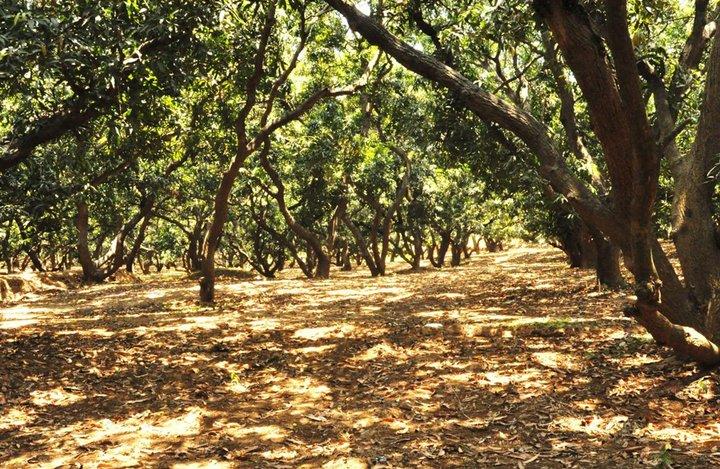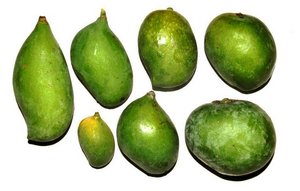Inherited orchards are a treasure trove of mango diversity in southern India

Take a virtual visit to Ranga Reddy's mango orchard, one of our custodian farmers in southern India. His orchard is home to 560 trees that make up 18 mango varieties, each with their own distinct qualities.
Mr Ranga Reddy’s mango orchard is typical of the Chittoor district of southern India’s Andhra Pradesh. Long rows of gigantic trees with dense foliage, soothing shadows with a cool breeze that wafts across, the murmur of fallen leaves, the tranquil call of chirping birds. However, unlike other orchards, this vast expanse of flat fertile land is home to about 560 trees that make up 18 varieties of mango popular in the area, each with their own distinct qualities.
“You may not have heard the names of these varieties,” says Mr Ranga Reddy. “Scientists say they are quite unique to our place.” Ranga Reddy is just one example of those considered to be ‘custodian farmers’ – men and women who actively maintain, adapt and disseminate agricultural biodiversity and related knowledge, over time and space, at farm and community levels and are recognized by community members for it.
Belonging to the Reddy caste of southern India, Ranga Reddy is a descendant of a land-owning group known for being cultivators and farmers. In fact, mangoes have always been an elite fruit of choice in India, and knowledge of their tastes and traits have traditionally been held by the upper classes of society.
“This Topu (orchard) is the fruition of my grandfather’s work and is over 70 years old.” explains Ranga Reddy. “I inherited it from my father and currently maintain it.” Many multi-variety mango orchards in Chittoor are the result of concerted efforts by the forefathers of orchard owners. Single-variety orchards did not traditionally exist in this area. Mangoes were, and still are, used to exchange with friends, neighbours and relatives; are given to guests during festivals and other celebrations; and are used to prepare delicacies with other fruits.
Each mango serves its own purpose. “Many of our mangoes are for market, but fruit yield is not the only reason we grow certain mangoes. Many other unique qualities are important to us,” explains Ranga Reddy. “Some are preferred for home consumption because of their delicious pulp. Some varieties are preferred because they keep for a long time. Some are sought for their juice, others make good pickles; some are for chutney and others are good for sharing with friends and relatives. I take pride in maintaining all of these.”
Ranga Reddy shows us one of his prized trees and offers us a taste. “We call this Chakkaraguttulu,” he smiles “the fruits are rather small, but have an excellent taste.” Chakkaraguttulu is a Telugu word which literally means ‘bunch of sugary fruits’, and indeed the fruits taste like sugar cubes in our mouths. The three varieties which Ranga Reddy considers special in his orchard are called Gadiyaram, Royal Special and Naati.
 We were visiting select mango orchards in Chittoor to study the good practices that contribute to on-farm diversity. The average mango orchard in Chittoor boasts more than four varieties, with an average richness of 4.7. From a genetic significance point of view, a multi-variety orchard is almost like a field genebank, hosting rare, indigenous mango varieties, some of which are the only one of their kind.
We were visiting select mango orchards in Chittoor to study the good practices that contribute to on-farm diversity. The average mango orchard in Chittoor boasts more than four varieties, with an average richness of 4.7. From a genetic significance point of view, a multi-variety orchard is almost like a field genebank, hosting rare, indigenous mango varieties, some of which are the only one of their kind.
Establishing an orchard takes a lot of effort, with extensive knowledge of soil and climate conditions, as well as related farming techniques. From a farmer’s point of view though, a multi-variety orchard is worth the effort because of the multiples uses and benefits that can be obtained from different varieties. They also help extend the mango season as different varieties may have different maturity and ripening periods.
A multi-variety orchard:
&nb
- ensures increased productivity of the orchard by allowing cross-pollination
- reduces risks from external factors such as market and weather fluctuations (due to different flowering and fruiting times; hardy varieties etc.)
- provides different uses which translates into different income and livelihood opportunities
- increases and contributes to on-farm genetic diversity, conserving a large pool of genetic resources for current and future use
These are just some of the many reasons why it is important to recognize the role that custodian farmers play in maintaining agricultural biodiversity, and to do what we can to support the continuation of those efforts.
This story is part of a series to celebrate traditional knowledge, contributed by our national partner from the UNEP/GEF supported project 'Conservation and Sustainable Use of Cultivated and Wild Tropical Fruit Diversity: Promoting Sustainable Livelihoods, Food Security and Ecosystem Services', implemented in India, Indonesia, Malaysia and Thailand. In India, the project is coordinated regionally by Bioversity International in collaboration with Indian Council of Agricultural Research (ICAR), New Delhi.
